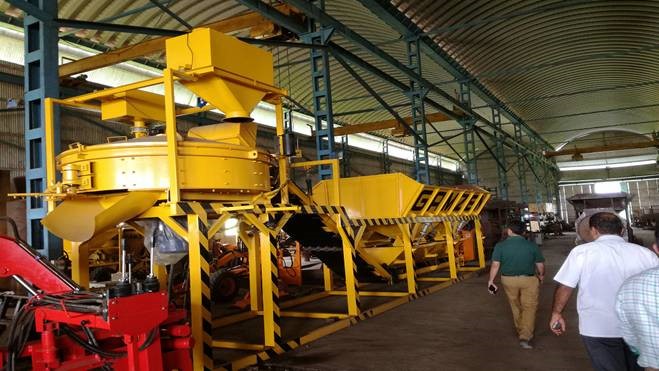Every large-scale project requires being efficient in all operations while upholding consistency and quality. Batching plants are a very vital aspect in the attainment of this state. This definitive guide will, therefore, help you in making a decision based on facts if you’ve been thinking of investing in a concrete batching plant for your project.
Understanding Concrete Batching Plants
Plants that combine all the raw materials for concrete—be it cement, water, sand, or aggregates—in exact proportions and dispatch them to a worksite are called concrete batching plants. To this effect, concrete batching plants play a leading role in quality assurance and producing high-quality concrete. The very essence of the stability and durability of every construction project is the production of good concrete.
Concrete Batching Plants Types
There are majorly two types of concrete batching plants: stationary and mobile.
- Stationary Batching Plants: These are the concrete plants which are designed for long term use and usually reside at one place over the project’s lifetime, also. Prolific in large volume concrete jobs.
- Mobile Batching Plants: They are very flexible as such can be easily moved from one site to another. Hence, they are quite suitable for work spread over different locations or even for smaller, more temporal projects.
Main Components of a Batching Plant Used for Concrete Production
A batching plant shall comprise the following key component systems:
- Mixers: These are indeed the heart of the operation; they are used in mixing the aggregate and raw materials to come up with quality, homogeneous concrete.
- Cement Silos: They are used as storage facilities for cement in advance before its dispensation to the mixer for making concrete; the storage process has to be carried out in the correct manner to maintain the quality of cement.
- Aggregate Bins: This stores the various size aggregates that are needed for structural purposes in the concrete.
- Control System: Most batching plants nowadays have automated control systems that will make sure that mixing is done to proportions and remains so in every batch of concrete that the plant will produce.
- Conveyor Systems: They transfer material in a plant house so that each constituent material reaches the mixer at the right time and in the proper proportion.
Benefits of Installing Concrete Batch Mix Plant
1. Enhanced Efficiency and Productivity
Setting up the concreter batching plant in your site can help check your project with greater efficiency. This is because the availability of fresh concrete will be on the site and you may not have to depend on other haphazard suppliers for delay in delivery and wasting time.
2. Improved Quality Control
The system will help in quality control of the concrete mix: proper weighing and mixing, along with automation, can assure that each concrete batch is made under the required standards for strength, durability, and consistency.
3. Cost Savings
While the upfront investment in a concrete batching plant could be high, cost savings over a long term are huge. By producing concrete at your site, you will save on transportation costs and reduce wastages besides minimizing the risk of project delays.
4. Flexibility in Production
Having your batching plant enables one to change mix design as per certain project requirements. If a different grade of concrete is required, or if the setting time needs to be faster, the batching plant changes parameters on-site and in real-time.
5. Environmental Considerations
Modern concrete batching plants are designed with due consideration to fulfill both the needs of your construction and the environment. It comes with features like dust collection systems, water recycling, and energy-efficient design.
Things to Consider Before You Install a Concrete Batching Plant
1. Size and Extent of Project
It has to be put into consideration that a concrete batching plant should be put up before starting your project. In case of going for large projects where there is a need to supply concrete all through, it is most likely that the stationary batching plant will be suitable. Otherwise, you can use a mobile batching plant that is relatively nimble or makes smaller batches.
2. Budget and Costs
Consider the budget constraint of the project. Long-term saving attributes have been attached with batching plants; hence, plan for a high upfront setup cost. Choose considering its installation, operation, and maintenance cost, if these two.
3. Availability of Space and Location
The location of a project site may dictate what kind of batching plant is called for. Make sure there is enough space for installation and operation of the plant, storage of raw materials, and easy access to transport vehicles.
4. Local Regulations and Permits
Understand the local laws and make sure to secure all the necessary permits before the installation of a batching plant. Otherwise, fines, delays in your project, or even the shutdown of your operation may be brought on by the violation of local laws.
5. Availability of Skilled Labor
Operation of a concrete batching plant would require a highly skilled workflow to man the equipment in proper order and operate it with quality control. Ensure that you have a skilled personnel liaison or are strongly dedicated to the training of personnel.
Steps to Install a Concrete Batching Plant
1. Site Preparation
First on the line of installation of a batching plant is to be prepared is the site. This includes ground leveling, preparing of drainage systems, and access ways on which construction vehicles can use to the site.
2. Foundation and Installation
The next step after site preparation involves laying the foundation for the plant. It is a very cautious process since the foundation has to be strong enough to hold the heavy machinery and equipment stable for the operation of the plant. Installation of all the components of a plant begins once the foundation has been prepared in a particular order in accordance with the instructions given by their manufacturer.
3. Calibration and Testing
During installation, the batching plant is calibrated by checking the full setup’s operation and doing necessary adjustments to the control systems. The mixing unit is subjected to trial runs for the production of concrete.
4. Training and Operation
The personnel must be trained after the installation of the plant. Such training should be aimed toward securing the plant operation by ensuring maximum performance, safety, and implementation of the quality standards.
5. Maintenance and Upkeep
Maintenance of the batching plant is supposed to be routine. It involves inspection routines, cleaning, repair as required, among other things. Proper maintenance of the plant will result in making uniform and high-quality concrete and increase its life span.
Conclusion
A concrete batching plant is a big investment, but one that brings returns in efficiency, quality control, cost economies, and flexibility. Well, set up the right size and scope of your project, budget, location, and regulatory requirements; therefore, you will make a good decision in relation to increased opportunities for success in your construction project.

